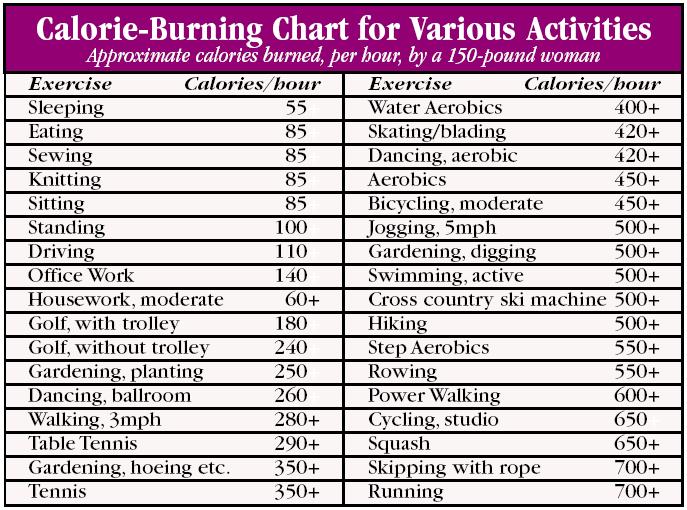Lack of blood & oxygen in infected area is THE CAUSE OF ALL PAIN
Burning
Calories
The Concept of CALORIES
CALORIES are needed to provide energy so the body functions properly. The number of calories in a food/diet depends on the amount of energy the food provides. The number of calories in a diet which a person needs depends on age, height, weight, gender, and activity level. People who consume more calories than they burn off in normal daily activity or during exercise are more likely to be over-weight.
How many calories we need on daily basis?
The actual amount of energy consumed per day is a simple formula:
The amount your body needs is the total amount of energy required for your heart to pump, your lungs to fill with air, your body to keep warm, your hair to grow, your stomach to digest food and all those things you generally don’t think about in a day. This is known as the basal metabolic rate. This is what your body would need regardless of what activities you do. Generally speaking the larger you are the higher your basal metabolic rate. Think about it: a woman with 100 pound weight needs less energy to breath and pump her heart than a 300 pound man. This is no different than the amount of fuel a Mazda Miata needs to drive around town compared with an army tank.
The basal metabolic rate is usually pretty static, that is to say, it doesn’t change. If your body needs 1,000 calories of energy a day for your basal rate then it will need the same amount tomorrow and the day after that. It is also important to note that everybody’s basal metabolic rate is different.
The amount your body needs to do extra things is the total amount of energy your body needs to lift heavy objects, or type on your computer or walk to the store, etc. This is all the stuff that you don’t need to do just to keep alive, but you choose to do for whatever reason. Let’s consider this to be the amount of work you do in a day.

CALORIC CHART FOR VARIOUS DIETS / FOODS (FOR ILLUSTRATION PURPOSES ONLY)
Food item |
Serving Size |
1cu=15gm carb |
Calorie(KCALS) |
Protein(gms) |
Fat(gms) |
Carb(CHO) |
|---|---|---|---|---|---|---|
| Main Course | ||||||
| Wheat Flour Chapati | 1(90gm flour) | 1/3 chapati | 240 | 7.2 | 0.6 | 48 |
| Tuar Dal (plain) | 1 katori | 1 katori | 100.5 | 6.69 | 0.51 | 17.28 |
| Paneer Palak | 1 serving | 1 serving | 407 | 8.3 | 36.3 | 11.6 |
| Jeera Aloo | 1 serving | 1serving | 209 | 1.3 | 15.1 | 17.1 |
| Plain steamed rice | 1katori | 3/4 katori | 86.25 | 1.7 | 0.12 | 19.55 |
| Breakfast | ||||||
| Idli | 1 idli(72.5gm) | 1 idli | 115.65 | 3.7 | 1.51 | 21.81 |
| Masala Dosa | 1(200gm) | Qtr dosa | 400 | 8 | 12 | 65 |
| Upma | 130 | 1katori | 210 | 55 | 9 | 26 |
| Banana | 1(100gm) | 43.5gm | 116 | 1.2 | 0.3 | 27.2 |
| Others | ||||||
| Chilli Chicken | 1 serving | 307.4 | 44.16 | 7.65 | 15.62 | |
| Cheese Burger | 1 sandwich | 1/2 | 310 | 15 | 12 | 35 |
| Cheese pan pizza | 1slice | 1/2 | 280 | 11 | 13 | 29 |
| French fries(Small) | 68gm | 39gm | 210 | 3 | 10 | 26 |
| Coca Cola (Medium) | 480ml | 179ml | 150 | 0 | 0 | 40 |
|
|
|
|
|
|
|
|
|
|
|
|
|
|
|
|
